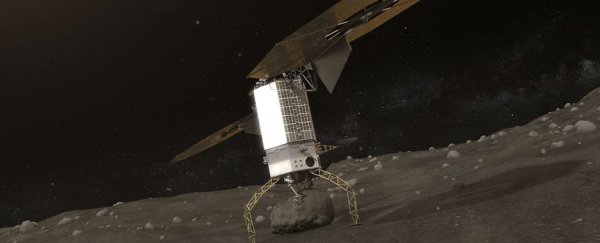NASA wants to be ready to save the world from a humanity-destroying asteroid impact - when the time comes - and it also wants to put people on Mars. For the record, we think both are totally worthy causes.
One of the stepping-stone missions to help accomplish both feats will see an unmanned spacecraft use something akin to a claw to capture a boulder from the surface of an asteroid.
It's the latest iteration of the asteroid redirect mission (ARM), which was first announced by NASA in April 2013.
The original idea for the ambitious mission was to try to capture an entire asteroid, about 8-metres-wide and weighing 500-metric-tonnes, in some kind of container or bag. It would have then been relocated to a stable lunar orbit where it could have been explored and analysed by astronauts.
But as Evan Ackerman explains from IEEE Spectrum, "the problem with this approach is that it's a one-shot deal: if the capture container fails for some reason, that's it, you're done, and the two year, US $1.25-billion mission amounts to something depressingly close to zilch."
The new plan is slightly more conservative and NASA hopes it will have a better chance of success. Instead of trying to capture an entire small asteroid, a capture spacecraft will be launched in 2020 to rendezvous with a much larger asteroid - possibly 100-metres-wide.
The craft, which will feature a giant claw, will fly alongside the asteroid for about 400 days, constantly scanning for candidate boulders, about 3-metres-wide, that it might be able to safely pluck from the surface.
NASA estimates that it will have about three to five attempts to make the grab, writes Ackerman for IEEE Spectrum.
If all goes to plan, the spacecraft will begin the six-year journey of moving its boulder into a stable lunar orbit for analysis.
This long journey will give the robotic ARM spacecraft an opportunity to test a number of capabilities needed for future human missions, including advanced Solar Electric Propulsion (SEP). While it's slower than conventional chemical propellants, it's likely a much cheaper option for long-haul journey, especially for cargo.
NASA says this technology could be useful for future missions into deep space by pre-positioning cargo or vehicles, which could be collected by manned crews as they pass.
We think all of this sounds awesome. And we hope it works. Still, I have some really crappy memories of spending hard-earned pocket change on THE CLAW in my youth, and coming up empty-handed, repeatedly.
Hopefully NASA has more luck with its claw than I ever did.
Source: IEEE Spectrum
